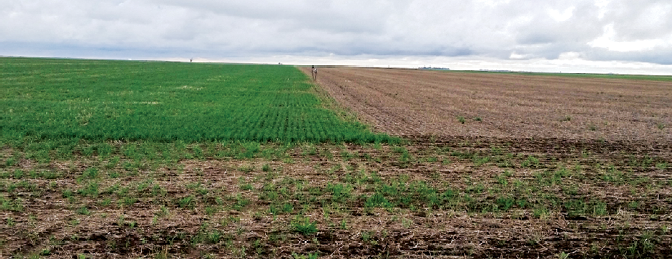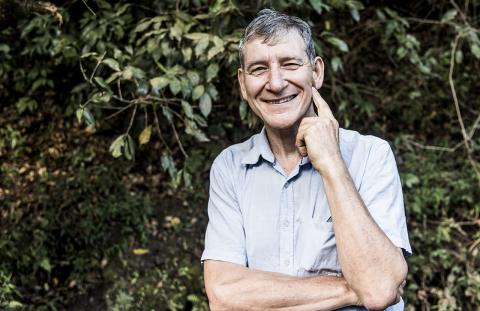ASSISTED NATURAL REGENERATION
ANR

“Sometimes you don’t need to plant anything, just to assist the natural regeneration of land … we can be really transformational if we build the capabilities of communities to do it themselves.”
- Nora Berrahmouni, Forestry Officer at the Food and Agriculture Organization (FAO)

EXPLAINING
ASSISTED NATURAL REGENERATION
Assisted Natural Regeneration (ANR) is a simple, low-cost forest restoration method that can effectively convert deforested lands of degraded vegetation to more productive forests. It is similar to Farmer-Managed Natural Regeneration (FMNR), with the only difference being that ANR is applied to degraded forestlands and rangelands, while FMNR is practiced on croplands.
As its name suggests, ANR aims to accelerate natural successional processes, removing or reducing barriers to natural forest regeneration. Instead of replacing the natural process, the method focuses on its barriers, such as soil degradation, competition with weedy species, and recurring disturbances (e.g., fire, grazing, wood harvesting) to reforest the land. More importantly, compared to conventional reforestation methods that involve the planting of tree seedlings, ANR offers significant cost advantages because it reduces or eliminates the costs associated with the seedlings themselves – from propagating, raising, and planting them.
THE GREEN PATH TO MORE PRODUCTIVE FORESTS
ANR is most effectively implemented at the landscape level in restoring the protective functions of forests, such as watershed protection and soil conservation. ANR techniques are flexible and allow for the integration of timber production, biodiversity recovery, and the cultivation of crops, fruit trees, and non-timber forest products in the restored forest. Preference for ANR may be given to areas where enrichment planting is carried out, favouring natural and local species used as sources of premium wood or non-timber forest products. In essence, Assisted Natural Regeneration provides a range of benefits: • a cost-efficient way of regenerating forest
• job opportunities for communities
• strengthens biodiversity
• makes hunting areas available
• contributes to climate change mitigation by increasing carbon sequestration and carbon sinks

TRANSFORMING LIVES AND LANDSCAPES
ANR'S IMPACTS
The assisted natural regeneration of trees on community forest lands and grasslands has been widely recommended in Asia for at least two decades. Government forest departments have nevertheless been slow to adopt ANR despite its return. Unfortunately, forest departments have historically been more focused on planting fast-growing timber trees in plantations. This solution has its roots in silvicultural engineering paradigms; and it fits more comfortably into forest department experiences and traditions.
Over the past several decades, significant efforts have been made to develop and apply ANR approaches to forest restoration, but much more can be done to implement these methods across millions of hectares.
Knowledge of ANR has grown considerably. It is now apparent there are additional opportunities to diversify strategies and to expand restoration work. Given its low cost and numerous advantages, the practice can be accepted and applied widely across the world. Surprisingly, however, assisted natural regeneration techniques are still vastly under-appreciated and under-utilised. This is in part due to the fact that few efforts have been made to promote ANR on a mass scale.
There have been exceptions – ANR has been promoted in the Philippines, China, and many other Asian countries. The use of ANR in agroforestry systems has also been reported in Brazil. Assisted natural regeneration of woodlands in Zimbabwe has been practised since the mid-1980s, as an alternative to or alongside state- or NGO-sponsored planting of exotic tree species in woodlots. In these countries, ANR initiatives are undertaken both communally and by individual farmers.
The most dramatic and renowned success with ANR in Africa has been achieved in the Shinyanga District in northwestern Tanzania. When President Julius Nyerere visited the Shinyanga Region in 1984, he was shocked by what he saw. Decades of deforestation and inappropriate land management had turned Shinyanga into the ‘Desert of Tanzania.’ The president immediately launched a program to help tens of thousands of smallholders to restore degraded land, and in doing so to significantly improve their incomes.
The HASHI project revived the traditional system of land management that emphasized the assisted natural regeneration of trees on degraded forest and grazing lands, which increases the supply of livestock fodder for use during the dry season. When the work began, there were just 600 ha of documented ngitili – enclosed fodder reserves – in the region. Nowadays, there are over 500,000 ha of such reserves, regenerated through the application of ANR.
The ngitili provide fuelwood and building timber as well as livestock fodder. Their rapid expansion has brought about a significant increase in biodiversity, as species that had disappeared decades ago are now returning to the landscape. The economic benefits have also been considerable. One study calculated the total monthly value of benefits derived from the ngitili to be US$14 per person – a significant sum in rural Tanzania.
Farmers were also encouraged to adopt a range of other agroforestry technologies, including the planting of woodlots, fodder banks, and fertiliser shrubs. These, too, have yielded considerable environmental and economic benefits. The Shinyanga District assisted natural regeneration project was the recipient of the UN Equator Prize in 2001, awarded to recognise its community’s outstanding effort to reduce poverty through the conservation and sustainable use of biodiversity. The regeneration of the ‘Desert of Tanzania’ holds lessons that could be a basis for models that help transform lives and landscapes in many other areas, in Africa and beyond, which have suffered from serious environmental degradation.A participatory approach involving the local community in the HASHI project led to the discovery of traditional land management practices like the ngitili from the Sukuma people. The local farmers would set aside a piece of land to allow it to regenerate, especially during the onset of the rain season – and used only at the peak of the dry season when fodder supply is difficult.


RECOVERING FERTILITY
IMPROVED FALLOWS
A fallow is a piece of farming land left inactive for a season with no crops planted to let it recover its fertility. The principle of an improved fallow is establishing trees or other perennials in crop fields to regenerate soil fertility during the period when the fields are left fallow. One way of establishing such species is to manipulate the ecological succession of the fallow vegetation. Mexican sunflower (Tithonia diversifolia) is managed in such a way in Mindanao, Philippines, and Austroeupatorium inulaefolium is managed similarly by farmers in Sumatra, Indonesia.
Another alternative is to deliberately introduce soil-building tree species into the field during the cultivation cycle, before the field is fallowed, so that they will grow throughout the fallow period. After 2-3 years the trees are then cut down and the leafy biomass incorporated into the soil as preparations are being made to resume cultivation. The woody material is used as firewood or construction materials.
A variant of this is to maintain a dispersed population of trees in the fields during the cultivation cycle in order to accelerate the restoration of the soil health, as well as to provide useful products. There are many examples of this practice in the Asia-Pacific region, involving both leguminous and non-leguminous soil-improving species. These include Leucaena leucocephala, as used in a number of fallow-rotation systems in Indonesia and the Philippines, Sesbania grandiflora and other Sesbania species, and Alnus nepalensis in northeast India, southwest China and northern Myanmar. A prominent and very similar example from central America is the quesungual agroforestry system.
Extension programmes on improved fallows have been implemented in western Kenya andeastern Zambia, where these systems had received considerable research attention. Studies later showed that there was considerable adoption by Zambian farmers, where land availability was more abundant and fallowing was practiced. However, in western Kenya there was only limited adoption because the practice of fallowing was rapidly disappearing in the farming systems of that area, primarily because of population pressures and decreasing farm size.

